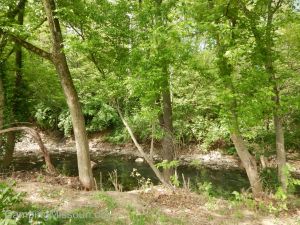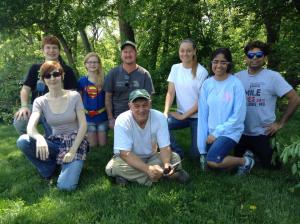Death to the Honeysuckle! Deer Creek Park Honeysuckle Hack 5/2/2015
Well it has been a busy Spring of volunteering just about every weekend on some natural restoration project (with a little camping and hiking throughout), be it at Missouri Stream Team cleanups, the Ozark Trail Mega Event, or this past Saturday in Deer Creek Park in Maplewood, MO removing a TON of honeysuckle growth along the creek bank with the Open Space Council for the St. Louis Region. I have posted about invasive species in Missouri before, as an overall problem that needs our attention, and this morning we were part of the laborious action that it takes to work toward the solution to that problem.
The Open Space Council is an organization whose mission is “to independently and collaboratively conserve and sustain land, water and other natural resources throughout the St. Louis region“. They have been around since 1965 and according to their website, they “have played an integral role in restoring and supporting a clean and healthy Meramec River, helping to establish Castlewood State Park, Forest 44 Conservation Area and Beetree County Park, restoring more than three thousand acres of land and almost 500 miles of river, permanently conserving an urban organic farm (which Earthdance Farms now owns & operates), and helping to thwart efforts to dam the Meramec River” (back in the sixties and seventies). They are also the organizers who put on an annual cleanup along the Meramec watershed called Operation Clean Stream, in which August of 2014, over 2200 volunteers in a single weekend removed 2481 tires and 250 cubic yards of trash from this beloved eastern Missouri waterway!
They do a lot in the St. Louis region for people that enjoy the outdoors right in our own communities, and today we were at the “Rocketship Park” in Maplewood to tackle the rampant honeysuckle growth along Deer Creek. The kids and I pulled up a little early and spent a few minutes at one of the picnic shelters discussing the day’s plan along with the effect of invasive species in our local ecosystem. A bright Saturday morning with Jay Doty, the Open Space Council representative running this event (and personal friend of mine), Bernie Arnold of the Arnold #211 Stream Team (another friend, who has removed honeysuckle and volunteered at cleanups along Deer Creek before) and a handful of other volunteers. Jay gave us a safety talk, we each grabbed either hand saws or loppers that were provided, and then walked along the asphalt path to the section we would be working on today.
When we arrived at the section of stream bank where the honeysuckle had not yet been removed at past events, we spread out and started cutting plants at the base, dragging them out of the woods, and piling them on the grassy area between the path and the riparian corridor. The visionaries of this project from the OSC and the city of Maplewood had concerns about bank erosion, so our goal was to leave the roots in the ground where it sloped toward the creek, to later be carefully and locally treated with herbicide at the cut. The next step would then be the planting of native species in the areas where it is needed.
 It was some hard work, but the weather was pleasant and everyone moved along in the same direction, working together cutting, dragging, and piling; doing our best to not harm each other in this flurry of moving decapitated honeysuckle. The piles were to be processed by Maplewood park workers within the next week, and we were building an impressive green levy of removed brush, flanking the asphalt walking path. Many bushes were narrow enough in diameter to slice off with the loppers, but a good amount had to be cut through with the handsaws, and then pulled up the bank to the collection above. The teamwork of everyone, standing solidly on the bank and passing the felled honeysuckle limbs up to the next person above in the chain made it a swift and encouraging process.
It was some hard work, but the weather was pleasant and everyone moved along in the same direction, working together cutting, dragging, and piling; doing our best to not harm each other in this flurry of moving decapitated honeysuckle. The piles were to be processed by Maplewood park workers within the next week, and we were building an impressive green levy of removed brush, flanking the asphalt walking path. Many bushes were narrow enough in diameter to slice off with the loppers, but a good amount had to be cut through with the handsaws, and then pulled up the bank to the collection above. The teamwork of everyone, standing solidly on the bank and passing the felled honeysuckle limbs up to the next person above in the chain made it a swift and encouraging process.
Something that I appreciated the most as we were working was the change in the look of the creek bank as we made our way along it. We would move into the next section, shaded and secluded by the arching branches and multiple green leaves blocking any view and cut them out, allowing the sunlight in. It opened up the creek bank along the edge of the park, and changed what some might consider a rather ignored stormwater pathway into the picturesque urban creek that it is, flowing past little league fields and families enjoying their community green space. That change, similar to looking back after a Stream Team cleanup, created an immediate sense of satisfaction. To see the young maple trees and cottonwoods and box elders bordering this rocky waterway standing proudly, freed from the choking brush that had been overtaking the scenery gave us all a feeling of accomplishment, opening up this little neighborhood waterway to how it ought to look.
But this is what I really do it for:
These invasive species weren’t brought into our regional ecosystems to destroy our forests and waterways. They were brought here with a lack of knowledge of the full scope of their effect. Honeysuckle isn’t a terrible plant. It just takes advantage of our environment in this spot on the globe, sucking up the resources and crowding out the plants that have always lived in balance with one another here in Missouri. It struck a chord in me a few months back when through my job I was able to attend an invasive species class, put on by the intelligent and articulate Tom Schweiss and the kind-hearted and knowledgeable Yvette Luedde, both of whom work for St. Louis County Parks.
 Standing in a closed-in porch at the end of an old building in Jefferson Barracks County Park, gazing out through the line of glass windows to the forest on the other side of the road, Tom brought to our attention that when the trees just yards away from us live out their lives and eventually fall to the forest floor, the honeysuckle that surrounds their feet will keep all the young trees from having a chance to take their place in the canopy. The natural cycle of the forest will be changed completely, and these massive giants that are so representative of Missouri river woods will not grow again, their descendants not even being given the opportunity to grow through the tangle of sub-canopy that has been established by the invasive honeysuckle throughout our region. It will change the shape and look of our landscape, the habitat for the animals that live within it, and the open spaces that we like to spend our free time in. It is already on its way, and it will take the community to set things right.
Standing in a closed-in porch at the end of an old building in Jefferson Barracks County Park, gazing out through the line of glass windows to the forest on the other side of the road, Tom brought to our attention that when the trees just yards away from us live out their lives and eventually fall to the forest floor, the honeysuckle that surrounds their feet will keep all the young trees from having a chance to take their place in the canopy. The natural cycle of the forest will be changed completely, and these massive giants that are so representative of Missouri river woods will not grow again, their descendants not even being given the opportunity to grow through the tangle of sub-canopy that has been established by the invasive honeysuckle throughout our region. It will change the shape and look of our landscape, the habitat for the animals that live within it, and the open spaces that we like to spend our free time in. It is already on its way, and it will take the community to set things right.
To get involved and volunteer to stop it, check out the Open Space Council’s volunteer page. Spend a Saturday morning with some great people, protecting the woods right in your own community. Be part of the solution to the problem of invasive species in Missouri.
Note: Most of the pictures on this post were taken by my adventurous daughter Sophie, which allows me to get into the work that I am there for. She is getting pretty awesome at it!

Sophie, taking a break from behind the lens, and Eli hard at work right next to us. I couldn’t be more proud of the two of them.








Where is Forest 44 Conservation Area? And way to go Sophie for not only helping but clickin pics too! 🙂
Forest 44 is a conservation area just southwest of the 44/141 interchange, behind a big horse stable complex. http://mdc4.mdc.mo.gov/applications/moatlas/AreaSummaryPage.aspx?txtAreaID=9023
And Sophie is having a lot of fun being behind the camera!